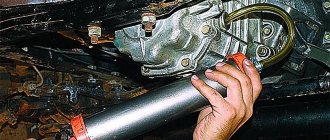- home
- Media center
- Articles
- What kind of oil is poured into KAMAZ power steering?
Menu
- News
- Articles
- Video materials
- Photo materials
- Publication in the media
- 3D tour
21.06.2019
Today, almost all relatively new tractors are available with power steering. Power steering allows the driver to spend less effort turning the steering wheel and stabilizes the movement of the vehicle. The steering on different models of Kama trucks works differently, and accordingly, the working fluids that lubricate the parts of the mechanisms will also differ.
For example, Kamaz 65115 has a left-hand steering wheel, in other words, the steering mechanism is located on the left side member of the vehicle frame. The steering wheel drive operates through the interaction of a driveshaft and sliding spline with an angular drive and bevel gears.
Power steering Kamaz 4310, 5320 have a blade structure with a gear drive of a pump driven by the engine crankshaft.
The basis for the operation of hydraulics, in addition to the mechanism parts, is hydraulic fluid. Power steering oil comes in various types. Liquids can be divided by color, composition, and varieties.
The space between the outer surface of the rotor, the plates, and the inner surface of the starter (in variable-volume chambers) is filled with oil. For complete filling, the composition is supplied from the side of the power steering pump housing and the recess of the distribution disk, which has six holes.
KAMAZ steering oil
While operating vehicles, you should clean the steering controls, check the fastenings and condition of the hoses of the parts, adjust the mechanisms and components, lubricate the components and parts, remove air from the power steering hydraulic system, add and periodically change the oil within the time limits specified in the lubrication chart.
Checking the oil level in the power steering reservoir is done on a warm engine with the wheels in the straight-ahead position. Before removing the filler plug, wipe the surface of the tank.
Oil is added when the engine is running at low shaft speeds through a funnel with a double mesh; The oil level should be between the marks on the indicator fixed in the plug.
Promotional offers based on your interests:
To avoid jamming and wear of carefully machined parts of the pump, steering mechanism, and control valve, only clean oil should be used.
Changing the oil in the steering of KamAZ-5320 and KamAZ-4310 vehicles is carried out with the longitudinal steering rod disconnected. To drain the oil, remove the pump cover and turn the steering wheels to the left until they stop, unscrew the steering gear drain plug and drain the oil.
Then remove and wash the filter and pump parts in gasoline, if there are viscous deposits, use a solvent for washing, and put the parts back in place.
Screw in the drain plug. Pour in 2 liters of clean oil and, turning the steering wheel all the way in both directions, flush the amplifier system and drain the oil again.
Screw the plug back in, replace the reservoir cap, and remove the rubber cap from the steering gear bypass valve. Place a hose onto the bypass valve head. Lower its second end into a transparent vessel with a capacity of at least 0.5 liters, half filled with oil. Pour oil through the filler neck and a funnel with a double mesh until the level stops decreasing.
Having unscrewed the bypass valve 0.5-0.75 turns, turn the steering wheel to the left until the force begins to increase (not all the way).
Start the engine and, working at low shaft speeds, add oil to the tank until the release of air bubbles from the hose stops, then close the valve.
Repeat a similar operation when turning the steering wheel to the right, and so on at least two or three times until the air flow stops.
After this, you should stop the engine, remove the hose, put on the rubber cap if necessary, add oil to the tank, close the tank lid and connect the longitudinal rod.
The basic maintenance operations for the steering control of a Ural-4320 car are largely similar, but at the same time there are some peculiarities.
Changing the oil in the hydraulic booster due to the presence of a hydraulic spare wheel lift is carried out in the following sequence.
After warming up the engine, warm up the oil in the hydraulic booster by vigorously turning the steering wheel in both directions.
Then, after lifting the front axle with a jack, disconnect the hoses from the amplifier cylinder: the front one from the fitting on the frame, the rear one from the hydraulic cylinder.
Remove the reservoir cap and turn the steering wheel in both directions to drain the oil. After the oil has drained, the spare wheel is lowered, i.e., the oil is drained from the hydraulic lift cylinder.
After washing the filter and connecting the hoses, pour oil into the tank.
After this, you need to start the engine and, working at low speeds, turn the steering wheel in both directions two or three times and set it to the left position until it stops. Add oil to the reservoir to the top mark. Raise and lower the spare tire two or three times and leave it in the raised position. Turn the steering wheel to the left again and add oil to the tank. Drain the oil in the same sequence.
Refill with 1.5 liters of oil, start the engine and turn the steering wheel left and right to remove air from the system.
Add oil to the tank to the top mark, lift the vac wheel two or three times and secure it in the top position. Check the level and add oil to the tank.
If an oil leak occurs along the amplifier cylinder rod, tighten the seal by turning the nut.
The steering components and parts should be disassembled only in cases of extreme necessity in enclosed spaces. The assembly and disassembly procedures are described in the relevant manuals.
When replacing damaged parts, do not disturb the completeness of the gears, spool and housing of the control valve, jet plungers, rotor parts, stator, and pump blades.
When operating the steering control, the following rules must be observed.
When moving the car out of a rut, you should not drive for a long time with the wheels turned to the extreme position, as this can lead to overheating of the fluid in the power steering system.
For the same reason, when the engine is running for a long time in place, the steered wheels should be set to the straight-line position.
In case of damage to the pump, destruction of hoses and when towing a vehicle1, movement should be short.
If the hoses rupture, connect the high and low pressure pipes, leaving the radiator on. Close the holes with wooden plugs, add oil to the tank to the required level. If there is no oil for the hydraulic booster, the oil used for the engine can be used. Continue driving, trying to operate at the lowest engine speed possible. If the oil overheats, stop and cool it.
After troubleshooting, drain the oil, flush the system with fresh oil intended for operating the amplifier, and remove air in the sequence described above.
It should be remembered that driving in acceleration and coasting modes, on long and gentle slopes with the engine turned off, is unacceptable, since the hydraulic power steering does not work in this case. This increases the free play of the steering wheel and the forces on it, which can lead to an emergency.
When maneuvering in tight spaces, increase engine speed to improve pump performance and hydraulic power steering efficiency.
Table of average fuel costs for KamAZ of various modifications
Different types of trucks differ in operating conditions and characteristics. This circumstance affects such an important point as fuel consumption of KamAZ per 100 km. Given the diversity of the model range, the indicator changes significantly. On average, consumption varies from 25 to 30 l/100 km, but large road trains can consume over 40 l.
For popular KamAZ brands, fuel consumption according to the manufacturer’s statements is given in the table.
| Car brands | Summer norm l/100km | Winter norm l/100km |
| 65116 (tractor tractor) | 24 | 26 |
| 6460 (tractor tractor) | 25 | 28 |
| 45143 (dump truck) | 26 | 29 |
| 65115 (dump truck) | 27 | 30 |
| 65111 (tractor) | 29,8 | 30,1 |
| 53228 (onboard) | 28 | 31 |
| 6520 (tractor) | 29,2 | 32,1 |
| 44108 (tractor) | 30 | 34 |
| 45141A (tractor) | 33,5 | 36,9 |
| 43114 (onboard type) | 31 | 34 |
| 43118 (onboard) | 33 | 36 |
| 65201 (tractor) | 37,1 | 40,8 |
| 6450 (tractor tractor) | 40 | 44 |
It is important to remember: from the table presented above it becomes clear that the indicators differ greatly from the power of the KamAZ engine, from the operating conditions and from the time of year. In addition, load has a significant impact.
Consumption figures are taken based on reference calculations. Information is provided by the manufacturer. However, drivers in practice may differ significantly, most often to a greater extent. This indicator is influenced by many factors, including the overall condition of the truck - engine, chassis, fuel system. It is advisable to regularly carry out technical inspections and take measurements in various situations - in summer and winter, with and without a load, on the highway and in the city.
What is acceptable fuel consumption on KamAZ?
In the field of cargo transportation, the 5320 brand tractor, equipped with a powerful engine, is popular. Fuel consumption per 100 km for such a KamAZ is about 34 liters. These are average figures, because the urban cycle for a diesel engine is always more expensive.
Lightweight versions of KamAZ with chassis 4308 use no more than 20 l/100 km. With small dimensions, the machine turns out to be more economical, but the range of tasks performed will be different. In the combined cycle, the consumption rate for such a car is 21-22 l/100 km.
The indicator is influenced by the following factors:
- Truck modification, make and type.
- Installed engine.
- Mileage and general condition.
- Time of year and operating conditions.
Winter fuel consumption rates are usually 2-4 liters higher. When making calculations, the condition of the machine should be taken into account. Brands 5490 are equipped with 800 liter tanks and under ideal conditions you can drive over 1000 km. However, for every hundred kilometers with a load of 3-4 tons, consumption will be greater.
KamAZ brand 65115 is a dump truck for various tasks. A modern modification of the chassis and engine shows an average fuel consumption of 30 liters per 100 km when driving on the highway at a speed of about 80 km/h. The base model only includes a tipper body, but trailers are also available. Based on the 65115 model, road trains are created that are used for transporting construction materials or agricultural products. Depending on what additional load is attached, consumption increases by 2-3 liters.
The 740-51-320 diesel engine is the most powerful and efficient. Its performance is 30-40 liters per 100 km, depending on the load and when driving at speeds up to 90 km/h. Engines of the Cummins series, which comply with Euro-4 standards, under ideal conditions consume up to 24 liters, but at maximum load the consumption is 37-40 l/100 km.
What kind of engine oil should be poured into KAMAZ power steering?
I am a great expert in the automotive field and have many articles on the topic of automotive repair. I have also written articles on the topic of truck maintenance more than once, including articles about domestic brands. I have experience in gearbox rebuilding and have top-level knowledge. I also have significant experience in servicing heavy trucks. For this reason, I definitely know the topic of this article by heart.
The question: what kind of oil should be poured into a Kamaz wheel drive worries many car owners and enterprise workers. You will receive the answer to this and other questions as you read the article. I also tried to give you all the recommendations so that each person can do everything on their own.
Types of power steering fluids
Before answering the question of what kind of power steering oil, you need to determine the existing types of these fluids.
Historically, it has happened that car enthusiasts distinguish them only by color, although this is not entirely correct. After all, it is more technically competent to pay attention to the tolerances that power steering fluids have. In particular: Therefore, when choosing, you must first pay attention to the listed characteristics, and then to the color. In addition, the following oils are currently used in power steering:
Let us list the advantages and disadvantages of each of the mentioned types of oils. So, the benefits of mineral oils include:
Disadvantages of mineral oils:
Advantages of fully synthetic oils :
Differences in color between different oils
Disadvantages of synthetic oils:
As for the common color gradation, automakers offer the following power steering fluids:
Many automakers use the same oil for automatic transmissions and power steering. In particular, these include companies from Japan. And European manufacturers require that a special fluid be used in hydraulic boosters. Many consider this a simple marketing ploy. Regardless of the type, all power steering fluids perform the same tasks. Let's take a closer look at them.
How to properly care for a gur
This applies not only to Kamaz, but to cars in general.
The guru won’t take much of your attention, but drivers only need to follow the basic norms and sets of rules that reduce the likelihood of a breakdown on the road, including reducing the likelihood of a breakdown due to the driver’s fault.
- Understanding how the guru works and being accountable for your actions is the most important thing.
- It is equally useful to know what kind of oil is used in the hydraulic booster.
- Also try to prevent the formation of leaks from the power steering system.
Signs of a power steering fluid leak
There are several simple signs of a power steering fluid leak. By their appearance, you can judge that it is time to change or top up. And this action is associated with choice. So, signs of a leak include:
If at least one of the listed symptoms appears, it is necessary to check the fluid level in the tank. And if necessary, replace or top up. However, before doing this, you should decide which liquid to use for this.
You cannot operate a car without power steering fluid, since this is not only harmful to it, but also unsafe for you and the people and cars around you.
Basic rules for servicing a Kamaz truck
The most important thing you should pay attention to when servicing a Kamaz wheel drive is the volume of lubricant in the tank. It is also necessary not to allow the amount of oil to decrease below the permissible value. In addition, you can monitor the condition of the Kamaz truck by the volume of sounds that the hydraulic booster produces when operating. Keep in mind that all extraneous noises that are made when the front wheels rotate and when the steering wheel is turned are a signal that you need to check the condition of the power steering.
The remaining standards for servicing the power steering system may be relevant only for its operation - remember that you should not overexert the steering wheel and turn it to extreme positions for more than a few minutes. This will cause excessive heating of the lubricant. Also, under no circumstances should you operate a car with a faulty power steering pump. Try to protect the power steering system from heavy loads and other road incidents that can easily cause an increase in pressure levels.
But it is no less useful to know about changing the mixture to a new one and choosing it wisely. Its level should be in the middle of the tank - that is, between the smallest and largest marks. You can often see markings for a heated and cooled engine. Nobody knows the exact standards and sequence of actions for changing the oil, but world experience says that changing the mixture in the Kamaz power steering should be done once a year.
The manufacturer always gives maintenance tips and recommendations for a specific oil product for power steering, but still the lubricant may not be at hand.
In addition, there are a lot of liquids on sale and many advisors. Try to figure it out...
The most popular brands of power steering lubricants
When there is no lubricant in the power steering system, it is better to fill in any substance. This will avoid subsequent system breakdown. Even an unsuitable composition will no longer be able to harm the rack seals, but it is important to immediately go to a service station to correct the problem.
When there is no suitable composition, it is best to use one of the most popular products:
We recommend: How does an internal combustion engine work and how does it work?
The lubricant in the hydraulic booster must be replaced every 30-45 thousand km. The absence of a substance can lead to system failure.
Checking oil quality
Before you start checking the oil in the gearbox, you need to find the place under the car hood where the checking dipstick is located (try not to confuse it with the dipstick for checking the lubrication in the car).
It is more rare to see the inscription COLD. In some systems, the lubricant must be given a certain amount of time to warm up properly.
If the amount of lubricant in the power steering is maximum, the liquid may also begin to foam as a result of interaction with oxygen and contact with the internal parts of the engine. The resulting consequences of the reaction will cause engine failure.
I would also note that the foam mixture will begin to increase in volume, and the working surplus will quickly be removed through the internal breather of the box.
Features of choosing liquid by color
All working fluids can be divided into two groups - mineral and synthetic. Basically, mineral products with additives are used. Synthetics in power steering are very harmful. This choice is due to the increased aggressiveness of the composition. Lubrication can lead to rapid destruction of the system.
The best option for using lubricant in power steering is to choose the original composition. The car manufacturer indicates in detail in the vehicle instructions which oil is best to fill in the power steering. An important parameter when choosing a suitable product can be the color of the lubricant. According to the existing rule, only compositions of the same color are allowed to be mixed.
Sometimes you can combine red lubricants with yellow ones. For the most part, this principle always works, but in some cases it can be violated. For example, green formulations are produced on both a mineral and a synthetic basis, and this indicates that it is absolutely impossible to combine such products. Let's look at the features of power steering lubricants by color:
We recommend: Clutch slave cylinder: repair or replacement?
What kind of gur liquids are there on the market?
Now we come to the most important thing. Remember that color does not play a role in this at all. Or rather, it plays minimally. The main thing when choosing a liquid for gur is the composition of the lubricant itself, as well as the presence of certain additives and the general component. Like many other lubricants, the oil base for gur can be classic - that is, synthetic, mineral or semi-synthetic.
Whatever lubricant you buy for your car, you definitely shouldn’t mix synthetic and mineral. Otherwise, lubricants of various compositions will lose their working properties and may begin to foam during vehicle operation. Especially if the driver often turns the steering wheel.
The channels may also become clogged and sediment may remain when the machine is running. However, this is half the problem. If you confuse synthetics and mix it with mineral water, the results of such actions will be the most terrible. Keep in mind that any car power steering has many sealing elements built into it. Including seal parts. Many of these elements are made from real rubber. If parts of similar composition come into contact in any way with synthetic oil, such oil will quickly spoil them.
What liquids can be mixed with each other?
Before adding oil to the power steering, you should find out what kind of fluid is in the car. Often the contents are determined by color, for example, only green or red (pink) liquid is poured into Ford Focus-2. Having determined the color, the car owner finds out that only two compounds are used on Focus cars:
We recommend: Fuel tank: structure, flushing, design.
It is not advisable to use anything else in the Ford Focus power steering, but you should know that red mineral oils such as Dextron can be mixed with each other in case of emergency.
Green and yellow liquids cannot be mixed; when they are combined, foaming occurs. But if a Mercedes car owner wants to replace the yellow grease in the steering system with green, it is necessary to do a flush, and then the power steering will work normally, without any problems. It is allowed to mix Dexron mineral water with yellow mineral liquid, nothing bad will happen. To understand a little what can be mixed and what cannot, you can look at the compatibility tables of auto chemicals from various manufacturers.
Group one. Here are oils that are conditionally interchangeable with each other - they are very similar in composition, only produced by different manufacturers. If you approach the issue strictly, these fluids should not be mixed, but mixing the compounds will not affect the power steering resource, and the steering system will work properly.
Green liquids
This is already Pentosin. In fact, one of the leading brands on the market and I would recommend it.
The danger is that the Pentosin mixture can come in the form of synthetics and in the form of a classic green mineral water. Therefore, you should be as careful as possible here. This oil is recommended for use in Kamaz trucks.
Accordingly, we can conclude that Pentosin and Dextron oils, in essence, for automotive power steering are simple factory mixtures with low viscosity.
The main thing to consider when mixing them with each other or when replacing these oils is the composition and its type (synthetic oil or mineral).
What kind of oil is poured into KAMAZ power steering?
Today, almost all relatively new tractors are available with power steering. Power steering allows the driver to spend less effort turning the steering wheel and stabilizes the movement of the vehicle. The steering on different models of Kama trucks works differently, and accordingly, the working fluids that lubricate the parts of the mechanisms will also differ.
Which oil to choose for a certain tractor model?
Hydraulic fluid, like a traffic light, can be red, yellow, or green. Some car owners are guided by the color aspect when choosing, however, this approach is not entirely correct. Also, some vehicle manuals indicate which colors can be mixed with each other. However, the possibility of mixing should be determined mainly by the composition, and not by the color scheme. After all, any liquid, mineral or synthetic, can be presented in any color.
- Red ATF transmission oil is mostly synthetic. The most popular brand is considered to be General Motors, namely the Dexron series. Although in this segment oils from well-known companies Motul, Shell, and Zik are considered no less popular.
- Yellow is produced mainly by one concern, Daimler, and is used in Mercedes-Benz trucks. There are two options available: synthetic or mineral.
- Green working fluid is the most universal, used in most power steering systems of various vehicles, it can be synthetic and mineral. This type is used in power steering, suspension, transmission systems and other mechanisms in which oil plays an important role. The green composition cannot be mixed with other colors only if the manufacturer declares full compatibility of the products. For example, green Comma is compatible with some types of red Dexron.
So, color difference plays a very important role. Different colors serve as a signal to the driver to combine different oils with the greatest care. However, color is only the tip of the iceberg of the distinctive features of working fluids. The most important is their composition, in other words, those components that manufacturers put in to improve hydraulic performance.
Is it possible to mix power steering fluids?
What should you do if you do not have the brand of fluid that your car's power steering system uses? You can mix similar compositions, provided that they belong to the same type ( “synthetics” and “mineral water” should not be mixed under any circumstances ). In particular, yellow and red oils are compatible . Their compositions are similar, and they will not harm the power steering. However, it is not recommended to drive this mixture for a long time. As soon as possible, replace your power steering fluid with the one recommended by your car manufacturer.
But green oil should not be added to red or yellow under any circumstances. This is due to the fact that synthetic and mineral oils cannot be mixed with each other.
Liquids can be divided into three groups , within which it is permissible to mix them with each other. The first such group includes “conditionally miscible” mineral oils of light colors (red, yellow). The figure below shows samples of oils that can be mixed with each other if there is an equal sign opposite them. However, as practice shows, mixing oils between which there is no equal sign is also acceptable, although undesirable.
Differences in composition
The composition of power steering fluids can be divided into mineral, semi-synthetic, and synthetic. The composition of the oil determines its chemical properties, which improve system performance. The following set of basic functions of oils are distinguished:
- The viscosity of materials plays a big role. Viscosity determines the flow capacity of the liquid into the mechanisms and the degree of envelopment of parts.
- The lubricating qualities for each mechanism, or for one mechanism but for different KamAZ models, will be different.
- Anti-corrosion protection of the system. Some oils, in addition to their lubricating properties, can protect parts from corrosion.
- Prevents foam formation. In hydraulics, most working processes take place under the influence of high temperatures. Often liquids simply boil or “go into foam.” To avoid this situation, it is necessary to use certain compounds.
- Different oils behave differently at different temperature coefficients and degrees of heating. Among other things, they have different hydraulic properties.
Almost all formulations are based on additives. It is the incompatibility of additives that causes the general incompatibility of liquids. For example, synthetics and mineral water are completely incompatible with each other precisely because of the radical difference in additives.
Synthetic oils
This type is one of the most innovative; it contains high-tech additives of a new type. All oil fractions pass through a special hydrocracking system. The main additives for synthetics are polyesters and polyhydric alcohols, which allow working with a wide temperature range, creating a long-lasting oil film on the working surfaces of parts, and also have a long service life, that is, they are rarely topped up or replaced, from maintenance to maintenance. If the hydraulic booster is designed for mineral oils, adding synthetics to it is strictly prohibited. Synthetics have an extremely aggressive effect on any rubber parts or surfaces, of which there are a lot in power steering. In hydraulics designed for synthetic fluids, the rubber is made in a special way and has a special silicone base, which is the least sensitive to aggressive environments.
Mineral compositions
The so-called “mineral waters” basically contain about 85-98 percent of petroleum fractions. The rest consists of various additives that improve the performance of hydraulic fluid. This type is used in hydraulic systems that have a large number of rubber-based parts, since mineral water has a neutral environment that does not corrode rubber surfaces.
Mineral compositions are considered the most budget-friendly, but their service life is correspondingly short. Good mineral oils are produced by Mobil and Dexron.
Is it possible to mix?
Mixing oils is acceptable, but must be done with great care. The main thing is to follow the manufacturer’s recommendations, which often indicate on the packaging which brands and classes can be mixed with. It is not recommended to make your own decision about mixing, for example, synthetics with mineral water, if the manufacturer does not give such recommendations. However, anything happens on the road, sometimes you have to fill in what you managed to find here and now. In this case, as soon as possible, it is recommended to completely drain the mixed fluids, replacing them with one used for this hydraulic system.
Engine oil
Is it possible to pour it into the power steering? The unequivocal answer is no. Transmission fluid is allowed to be filled only in certain cases and quantities. The main reason for this precaution is the different functional characteristics of different types of oils. What qualities should power steering compounds have?
- Mandatory lubricating effect.
- Protective properties against metal corrosion, increasing the wear resistance of parts.
- By means of bypass valves, create pressure inside the system.
- Prevent foam formation.
- Cool the system.
These properties are possible thanks to various additives added in different proportions. Motor oil has a slightly different functionality, so it may simply not cope with the work of hydraulics. Transmission compounds have separate reservations, due to the presence of additives in them; some Japanese manufacturers recommend using ATF as a universal fluid. Europeans, on the contrary, call for separating hydraulic and motor oils.
That is why the question “what kind of fluid to pour into the hydraulic system” can be given a definite answer - recommended by the vehicle manufacturer. If the technical documentation from the car has not been preserved, this information can be found on the tank or lid. In any case, it is unacceptable to experiment with compounds on your own, because the hydraulic unit is one of the systems that ensures the safe movement of the vehicle and its stabilization on the road.
Kamaz trucks usually require about four liters of working hydraulic fluid. This is approximately four times more than what is poured into a passenger car. Volumes may be slightly smaller or larger (depending on the Kamaz model).
Level control is visible in the expansion tank, which has two main marks - minimum and maximum. The ideal level is between these indicators. If it is minimal, you need to urgently top it up; if it is maximal (due to high temperatures), the liquid may overflow, forming smudges.
What to pour into the power steering
The answer to this question is simple - the fluid that your car manufacturer recommends. And it is unacceptable to conduct experiments here. The fact is that if you constantly use oil that is not suitable in composition for your power steering, then over time there is a high probability of complete failure of the hydraulic booster.
Therefore, when choosing which fluid to pour into the power steering, the following factors must be taken into account:
Also, many car owners are interested in questions about whether it is possible to pour transmission oil into the gearbox? Or motor oil? As for the second, it’s worth saying right away - no. But as for the first ones, they can be used, but with certain reservations.
The two most common types of fluids are Dexron and Power Steering Fuel (PSF). Moreover, the first one is more common. Currently, fluids that meet the Dexron II and Dexron III standards are mainly used. Both compounds were originally developed by General Motors. Dexron II and Dexron III are currently produced under license by numerous manufacturers. They differ from each other in the temperature range of use. The German concern Daimler, which includes the world famous Mercedes-Benz, has developed its own power steering fluid, which is yellow in color. However, there are many companies in the world that produce such compounds under license.
Compliance of machines and power steering fluids
Here is a small table of correspondence between power steering fluids and specific car brands.
| car model | Power steering fluid |
| FORD FOCUS 2 (“Ford Focus 2”) | Green - WSS-M2C204-A2, Red - WSA-M2C195-A |
| RENAULT LOGAN (“Renault Logan”) | Elf Renaultmatic D3 or Elf Matic G3 |
| Chevrolet CRUZE (“Chevrolet Cruze”) | Green – Pentosin CHF202, CHF11S and CHF7.1, Red – Dexron 6 GM |
| MAZDA 3 (“Mazda 3”) | Original ATF M-III or D-II |
| VAZ PRIORA | Recommended type - Pentosin Hydraulik Fluid CHF 11S-TL (VW52137) |
| OPEL (“Opel”) | Dexron different types |
| TOYOTA (“Toyota”) | Dexron different types |
| KIA (“Kia”) | DEXRON II or DEXRON III |
| HYUNDAI (“Hyundai”) | RAVENOL PSF |
| AUDI (“Audi”) | VAG G 004000 M2 |
| HONDA (“Honda”) | Original PSF, PSF II |
| Saab (“Saab”) | Pentosin CHF 11S |
| Mercedes (“Mercedes”) | Special yellow compounds for Daimler |
| BMW (“BMW”) | Pentosin chf 11s (original), Febi S6161 (analogue) |
| Volkswagen (“Volkswagen”) | VAG G 004000 M2 |
| Geely (“Geely”) | DEXRON II or DEXRON III |








